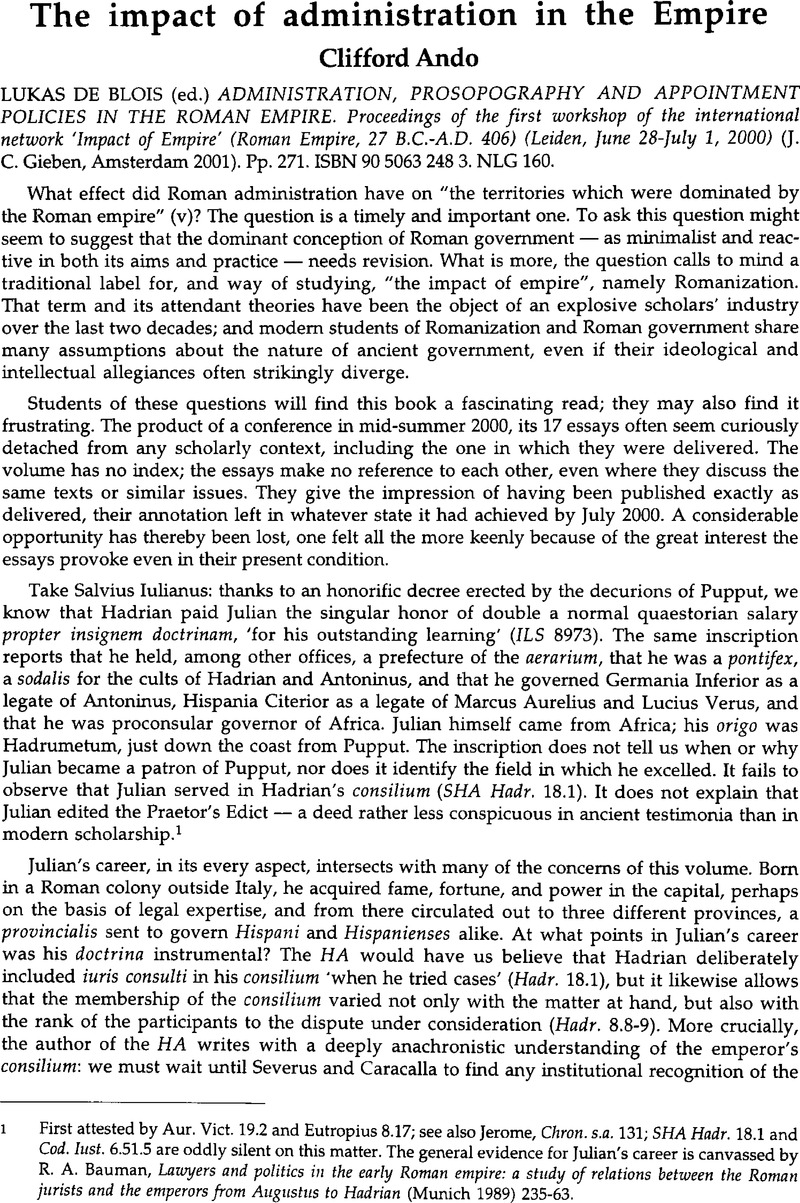No CrossRef data available.
Article contents
The impact of administration in the Empire - Lukas De Blois (ed.) ADMINISTRATION, PROSOPOGRAPHY AND APPOINTMENT POLICIES IN THE ROMAN EMPIRE. Proceedings of the first workshop of the international network ‘Impact of Empire’ (Roman Empire, 27 B.C.-A.D. 406) (Leiden, June 28-July 1, 2000) (J. C. Gieben, Amsterdam 2001). Pp. 271. ISBN 90 5063 248 3. NLG 160.
Published online by Cambridge University Press: 16 February 2015
Abstract

- Type
- Reviews
- Information
- Copyright
- Copyright © Journal of Roman Archaeology L.L.C. 2002
References
1 First attested by Aur. Vict. 19.2 and Eutropius 8.17; see also Jerome, Chron. s.a. 131; SHA Hadr. 18.1 and Cod. Iust. 6.51.5 are oddly silent on this matter. The general evidence for Julian's career is canvassed by Bauman, R. A., Lawyers and politics in the early Roman empire: a study of relations between the Roman jurists and the emperors from Augustus to Hadrian (Munich 1989) 235–63Google Scholar.
2 Cf. Cotton, H., Documentary letters of recommendation in Latin from the Roman Empire (Königstein 1981) 30–33 Google Scholar.
3 Leunissen, P. M. M., “Conventions of patronage in senatorial careers under the Principate,” Chiron 23 (1993) 101–20Google Scholar.
4 Purcell, N., “The apparitores: a study in social mobility” PBSR 51 (1983) 127–73Google Scholar.
5 Christol, M. “L'ascension de l'ordre équestre. Un thème historiographique et sa réalité,” L'ordre Équestre: histoire d'une aristocratie (IIe siècle ap. J.C.-IIIe siècle ap. f.C.) (CollEFR 257, 1999) 613–28Google Scholar.
6 Flaig, E., Der Kaiser herausfordern. Die Usurpationen im römischen Reich (Frankfurt 1992)Google Scholar.
7 See Potter, D., “Palmyra and Rome: Odaenathus' titulature and the use of the imperittm matus ,” ZPE 113 (1996) 271–85Google Scholar; Leadbetter, B., “‘Patrimonium indivisum’? The empire of Diocletian and Maximian, 285-289,” Chiron 28 (1998) 213–28Google Scholar.
8 Readers might wish to compare the methods and results on display in Dondin-Payre, M., “Magistratures et administration municipale dans les Trois Gaules,” in ead. and Raepsaet-Charlier, M.-T., Cités, municipes, colonies. Les processus de municipalisation en Gaule et en Germanie sous le Haut Empire romain (Paris 1999) 127–230 Google Scholar.
9 Cf. my review of J. Matthews' Laying down the law and J. Harries' Law and empire in late antiquity, forthcoming in Phoenix.
10 Frier, B., The rise of the Roman jurists: studies in Cicero's Pro Caecina (Princeton 1985)CrossRefGoogle Scholar.
11 See Ando, C., Imperial ideology and provincial loyalty (Berkeley 2000) 373–85CrossRefGoogle Scholar.
12 See, e.g., P. Tebt. 2.286, on which see Ando ibid. 378
13 Cf. now Gascou, J., “Unites administratives locales et fonctionnaires romains. Les données des nouveaux papyrus du Moyen Euphrate et d'Arabie,” in Eck, W. (ed.), Lokale Autonomie und römische Ordnungs-macht in den kaiserzeitlichen Provinzen vom 1. bis 3. Jahrhundert (Munich 1999) 61–73 Google Scholar.
14 See Thomas, Y., “Origine” et “commune patrie.” Étude de droit public romain (89 av. J.-C.-212 ap. J.-C.) (CollEFR 221, 1996)Google Scholar.
15 Cf. Ando, C., “Was Rome a polis?” ClassAnt 18 (1999) 5–34 Google Scholar.
16 Nicolet, Cl., Financial documents and geographical knowledge in the Roman world (Oxford 1996)Google Scholar.
17 Moatti, C., La raison de Rome (Paris 1997) 57–95 Google Scholar.
18 Wallace-Hadrill, A., “ Mutatio morum: the idea of a cultural revolution,” in Habinek, T. N. and Schiesaro, A., The Roman cultural revolution (Cambridge 1997) 3–22 Google Scholar.


